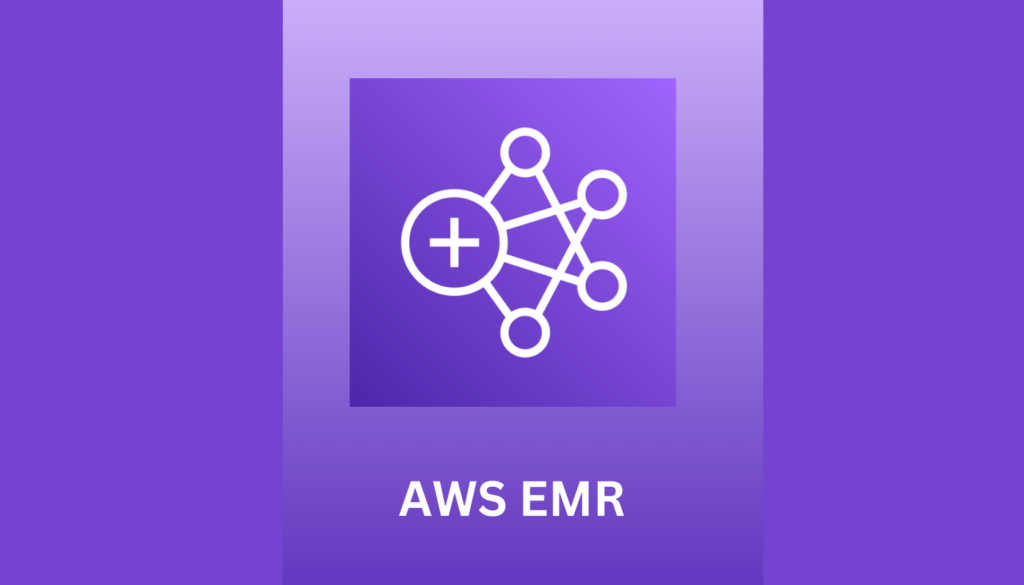What is AWS EMR?
AWS EMR is a cloud-native big data platform, designed to efficiently process vast amounts of data. It simplifies the running of big data frameworks, such as Apache Hadoop and Apache Spark, on AWS to analyze and process large datasets. AWS EMR can scale resources up or down quickly to handle jobs of any size, which helps in managing costs effectively.
It enhances data processing capabilities, allowing you to focus on analyzing data rather than managing infrastructure. This service is particularly beneficial for businesses and developers dealing with data transformation, analysis, and visualization on a large scale.

Source: Amazon EMR
What Are The Features Of AWS EMR?
AWS Elastic MapReduce (EMR) comes packed with a suite of features designed to make big data processing more efficient and user-friendly. Each feature brings unique capabilities to the table, enhancing how businesses and developers can handle large-scale data.
1. Scalability and Flexibility
One of the most significant advantages of AWS EMR is its scalability. You can easily resize your clusters by adding or removing instances, which allows you to manage computational resources according to your processing needs. This flexibility means you can handle varying workloads efficiently, ensuring that you’re only using (and paying for) the resources you need.
2. Data Processing Engines
AWS EMR supports multiple big data frameworks, such as Hadoop, Spark, HBase, Presto, and Flink. This versatility allows you to select the most appropriate data processing engine for your specific task, whether it’s data processing, web indexing, machine learning, or any other big data application.
3. Integration and Connectivity
EMR seamlessly integrates with other AWS services, like S3, DynamoDB, and Redshift, allowing for easy data import and export. This connectivity ensures that you can incorporate EMR into your existing AWS ecosystem without hassle, making it a flexible option for diverse data processing requirements.
4. Security and Compliance
Security in AWS EMR is robust, with features like AWS Identity and Access Management (IAM) for fine-grained access control and encryption options for data at rest and in transit. Compliance with various standards and regulations ensures that your data processing aligns with industry best practices.
5. Monitoring and Analysis Tools
AWS EMR provides monitoring tools such as Amazon CloudWatch and integration with third-party tools, enabling you to track the performance of your clusters. This monitoring is crucial for optimizing resource usage, troubleshooting issues, and improving the overall efficiency of your data processing tasks.
6. User Interface and Accessibility
The AWS Management Console offers a user-friendly interface for managing EMR clusters. You can also use the AWS Command Line Interface (CLI) or SDKs for more programmatic control. These interfaces make it easier to launch, monitor, and manage your big data applications, regardless of your technical background.
Through these features, AWS EMR stands as a comprehensive solution for big data processing, offering the flexibility, scalability, and integration capabilities necessary for handling large datasets effectively in the cloud.
Pricing Overview
Understanding the pricing structure of AWS Elastic MapReduce (EMR) is crucial for effective budgeting and cost management. AWS EMR offers a variety of pricing components and models to cater to different usage patterns and requirements.
AWS EMR Pricing Components
AWS EMR pricing is primarily based on the type of instances used and the region in which your instances are running. Key pricing components include:
- EC2 Instances: You’re charged for the EC2 instances used in your EMR clusters, which can vary based on the instance type and region.
- EMR Cost: This is a separate charge for the EMR service itself, calculated per instance hour consumed.
- Data Transfer: Data transfer costs can occur when data moves between different AWS services or regions.
- Storage: If you use additional AWS storage services, like S3 or EBS, their respective costs will apply.
Pricing Models and Plans
AWS EMR offers different pricing models to suit various user needs:
- On-Demand Pricing: Pay for the compute capacity by the hour without long-term commitments. This option is suitable for short-term, irregular workloads.
- Reserved Instances: For long-term requirements, you can reserve EMR capacity at a significantly reduced rate compared to on-demand pricing.
- Spot Instances: Utilize unused EC2 capacity at a lower price, suitable for flexible and fault-tolerant workloads.
What Is Included In AWS EMR Free Tier?
AWS EMR itself doesn’t have a free tier, but you can use the EC2 instance free tier option with this, which includes:
- 750 hours per month of t2.small instances for up to 12 months: Ideal for trial and small-scale projects.
- No charge for the EMR service itself: You’re only charged for the underlying EC2 instances and any other AWS resources you use.
Understanding these pricing components and models can help you choose the most cost-effective options for your EMR workloads. It’s important to align your selection with your processing needs and budget constraints to optimize your expenditure on AWS EMR.
How To Optimize Costs In AWS EMR?
Optimizing costs while using AWS Elastic MapReduce (EMR) is crucial for maintaining an efficient and economical big data processing environment. By implementing specific strategies, you can significantly reduce expenses without compromising on performance.
1. Efficient Resource Utilization
Properly sizing your EMR clusters is vital. Use Amazon CloudWatch metrics to monitor your resource utilization and adjust the size of your clusters based on actual needs. Avoid over-provisioning, and scale down when processing demands decrease.
2. Usage Scheduling
Schedule your EMR clusters to run only when needed. Utilize AWS Lambda and AWS CloudWatch Events to automate the starting and stopping of clusters based on schedule or demand, ensuring you’re not paying for idle resources.
3. Selecting the Right Instance Types
Choose the most cost-effective EC2 instance types for your workload. Consider using lower-cost instances for less demanding tasks and reserve more powerful instances for compute-intensive jobs.
4. Spot Instances and Reserved Instances
Leverage Spot Instances for non-critical, flexible workloads to take advantage of lower prices. For consistent and predictable workloads, consider Reserved Instances to enjoy cost savings over the long term.
5. Auto-Scaling Strategies
Implement auto-scaling to automatically adjust the number of instances in your cluster. This ensures that you’re using the optimal amount of resources, scaling up during high demand and scaling down during low usage periods.
6. Optimizing Data Storage
Efficiently manage data storage to reduce costs. Use Amazon S3 for long-term, cost-effective storage, and consider using the EMR File System (EMRFS) to optimize data processing and transfer between EMR and S3.
By adopting these cost optimization strategies, you can achieve a balance between performance and cost, ensuring that your AWS EMR usage is both efficient and economical. Regularly review and adjust your approach in line with your changing processing requirements and AWS’s evolving offerings.
Conclusion
AWS Elastic MapReduce (EMR) is a powerful and versatile service for handling big data workloads in the cloud. It offers scalable and flexible data processing capabilities, integrates seamlessly with other AWS services, and provides robust security features. Understanding its pricing structure and adopting cost optimization strategies can lead to significant savings. To leverage AWS EMR effectively, it’s advisable to consult with professionals who can help tailor the service to meet specific data processing needs.
Ready to elevate your AWS strategy?
[Reach out] for specialized guidance to ensure your setup is both cost-effective and high-performing.

